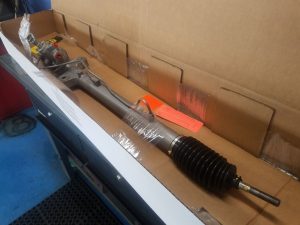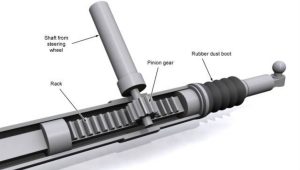


Steering St. Louis Auto RepairYour vehicle’s Steering System is vital to maintaining safe operation. It provides precise control of the front-wheel direction and sometimes the rear-wheel direction as well. Your Steering System also transmits the feel of the road to your hands, absorbs most of the shock to the steering wheel and allows for suspension action without affecting the direction of the front wheels.
There are two basic kinds of steering systems in use today: linkage and rack-and-pinion. Linkage Steering Systems are found on large, full-size pickup trucks and full-size vans. Rack-and-pinion steering systems are lighter and are better for passenger cars and small trucks.
The Basic Linkage Steering System includes the steering wheel, the steering shaft and column, the gearbox, linkage and ball sockets. The wheel rotates the steering shaft, which transfers the movement through the gearbox and the linkage out to the steering knuckles.
The Basic Rack-and-Pinion Steering System also starts with the steering wheel, column and shaft. Instead of a gearbox, this movement is transferred to a Steering Pinion Gear that has teeth that mesh with gear teeth on the rack which is a steel bar that slides sideways as the pinion gear turns. All of this happens inside a gear housing that encloses the pinion gear and rack. At the ends of the rack are tie-rods, which are steel rods with swivel sockets on each end that connect the rack with two front steering knuckles.
Most vehicles today have Power Assisted Steering which means there is an engine-driven pump and hydraulic system to assist the steering action. In many cases, this pump is powered by a belt running from the engine crankshaft pulley. This pump can work in several different ways and be placed in front or behind the engine, but its purpose is the same. It is important for this pump to work properly and have the power steering fluid in this pump checked regularly for amount and cleanliness to keep it running. There are several high-pressure, hydraulic rubber hoses that connect the power steering pump to the gear box or power cylinder. Metal lines may be used as well in some cases.

When troubleshooting Steering System problems, a qualified technician will start with a check of power steering fluid levels, incorrect belt adjustment, system leaks, a test drive and a look at all components while your vehicle is raised on an automotive lift. Any excessive loose movement (play) in the steering system may indicate that parts are worn, damaged or out of alignment and will need to be assessed. As with many other vehicle issues, it is important for the driver of the vehicle to notice what sensations are being transmitted through the steering wheel, and to let your Advisor know what you are experiencing as far as feel, noises heard and whether things are felt during straight driving or just when turning the wheel.
Today’s newer vehicles have electronic power steering and all the older Hydraulic Power steering systems are starting to become a thing of the past so troubleshooting problems becomes a matter of understanding the electronic components that control our vehicles.
Give us a call today at 314.423.3876 to schedule a time for us to look over the Steering System in your vehicle and we will make recommendations to keep you driving safely in the right direction.
